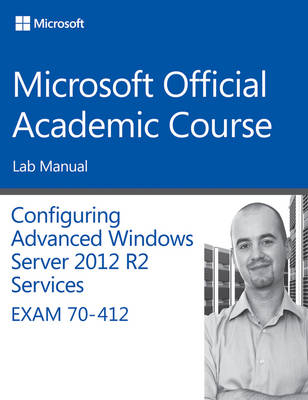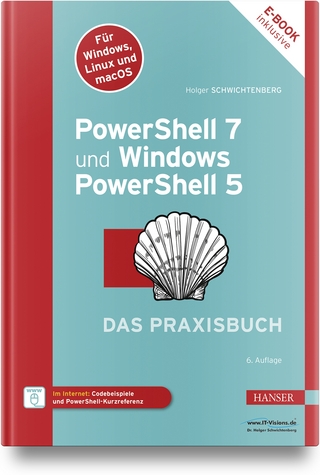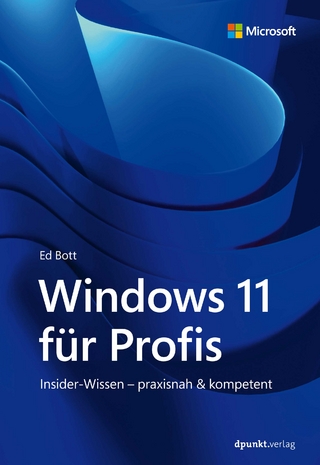
70–412 Configuring Advanced Windows Server 2012 Services R2 Lab Manual
John Wiley & Sons Inc (Verlag)
978-1-118-88302-0 (ISBN)
- Titel ist leider vergriffen;
keine Neuauflage - Artikel merken
This is the print lab manual adjacent to the 70-412
Configuring Advanced Windows Server 2012 R2 Services
textbook. 70-412 Configuring Advanced Windows Server 2012
R2 Services covers the third of three exams required for
Microsoft Certified Solutions Associate (MCSA): Windows Server 2012
certification. This course will help validate the skills and
knowledge necessary to administer a Windows Server 2012
Infrastructure in an enterprise environment. The three MCSA exams
collectively validate the skills and knowledge necessary for
implementing, managing, maintaining and provisioning services and
infrastructure in a Windows Server 2012 environment. This Microsoft
Official Academic Course is mapped to the 70-412 Configuring
Advanced Windows Server 2012 Services exam skills, including the
recent R2 objectives. This textbook focuses on real skills for real
jobs and prepares students to prove mastery of Advanced Windows
Server 2012 Services such as advanced configuring tasks necessary
to deploy, manage, and maintain a Windows Server 2012
infrastructure. It covers such skills as fault tolerance,
certificate services, and identity federation. In addition, this
book also covers such valuable skills as:
? Implementing Advanced Network Services
? Implementing Advanced File Services
? Implementing Dynamic Access Control
? Implementing Network Load Balancing
? Implementing Failover Clustering
? Implementing Disaster Recovery
? Implementing Active Directory Certificate Services (AD
CS)
? Implementing Active Directory Federation Services (AD
FS)
The MOAC IT Professional series is the Official from Microsoft,
turn-key Workforce training program that leads to professional
certification and was authored for college instructors and college
students. MOAC gets instructors ready to teach and students ready
for work by delivering essential resources in 5 key areas:
Instructor readiness, student software, student assessment,
instruction resources, and learning validation. With the Microsoft
Official Academic course program, you are getting instructional
support from Microsoft; materials that are accurate and make course
delivery easy. Request your sample materials today.
The Microsoft Official Academic Course (MOAC) Program is the official product for Microsoft Programs in higher education. These learning products are created especially for the academic market and combine the business world focus and market research of Microsoft with 200 years of successful higher education publishing from Wiley. The program is based upon the same curriculum as the Microsoft IT Certifications to build the skills students need to succeed at work and the preparation they need to validate those skills and get the jobs they seek. All the support instructors need to deliver great courses on Microsoft software is in the program. Student copies of the textbooks include the trial software in select markets and student files for completing homework assignments. Microsoft Updates will bring you the latest information on new products and curriculums and are a part of the program. MOAC is a great way for instructors to get ready to teach and for students to get ready for work.
1. Configuring Network Load Balancing 1
Exercise 1.1: Installing the Network Load Balancing Feature 3
Exercise 1.2: Creating an NLB Cluster 5
Exercise 1.3: Configuring DNS 7
Exercise 1.4: Configuring Cluster Properties 8
Exercise 1.5: Managing Cluster Nodes 9
Exercise 1.6: Removing an NLB Cluster 10
Lab Challenge: Upgrading an NLB Cluster 12
2. Configuring Failover Clustering 13
Exercise 2.1: Configuring the iSCSI Client 15
Exercise 2.2: Installing Failover Clustering 18
Exercise 2.3: Creating a Failover Cluster 18
Exercise 2.4: Configuring the Quorum 22
Exercise 2.5: Configuring a Clustered Storage Space 23
Exercise 2.6: Implementing Cluster Aware Updating 25
Lab Challenge: Upgrading a Failover Cluster 28
3. Managing Failover Clustering 29
Exercise 3.1: Deploying the General Use File Server Role 31
Exercise 3.2: Deploying Scale-Out File Server 33
Exercise 3.3: Configuring Failover and Preference Settings 34
Exercise 3.4: Managing a Cluster and Cluster Nodes 36
Exercise 3.5: Destroying a Cluster 37
Lab Challenge: Configuring VM Monitoring 38
4. Managing VM Movement 39
Exercise 4.1: Moving a VM Storage Location 40
Exercise 4.2: Moving a VM to Another Host 42
Exercise 4.3: Copying a VM 44
Lab Challenge: Configuring Computers for Live Migration 45
5. Configuring Advanced File Solutions 47
Exercise 5.1: Creating an NFS Shared Folder 49
Exercise 5.2: Installing and Configuring BranchCache 51
Exercise 5.3: Using File Classification 54
Exercise 5.4: Configuring File Access Auditing 57
Lab Challenge: Creating an NFS Shared Folder on a Cluster 61
6. Implementing Dynamic Access Control 63
Exercise 6.1: Using Dynamic Access Control (DAC) 64
Exercise 6.2: Implementing a Central Access Policy 71
Lab Challenge: Performing Access Denied Remediation 77
7. Configuring and Optimizing Storage 79
Exercise 7.1: Removing an iSCSI Target 81
Exercise 7.2: Creating and Configuring an iSCSI Target 82
Exercise 7.3: Configuring iSCSI Initiator 85
Exercise 7.4: Configuring Tiered Storage 88
Exercise 7.5: Using Features on Demand 89
Lab Challenge: Implementing Thin Provisioning 91
8. Configuring and Managing Backups 93
Exercise 8.1: Installing the Windows Server Backup 95
Exercise 8.2: Performing a Manual Backup of a Local Folders to a Remote Share 95
Exercise 8.3: Backing up the System State 98
Exercise 8.4: Managing VSS Settings 99
Exercise 8.5: Enabling Shadow Copies for Shared Volumes 100
Lab Challenge: Using Hyper-V Snapshots 102
9. Recovering Servers 103
Exercise 9.1: Restoring a Folder Using Windows Server Backup 104
Exercise 9.2: Restoring the System State of a System 106
Exercise 9.3: Restoring a File Using Shadow Copy 106
Exercise 9.4: Booting into Safe Mode 108
Exercise 9.5: Using Command Prompt Repair Tools 112
Lab Challenge: Performing an Authoritative Restore 114
10. Configuring Site-Level Fault Tolerance 115
Exercise 10.1: Configuring and Enabling Hyper-V Replication 117
Exercise 10.2: Configuring Replication for a VM 119
Lab Challenge: Configuring Multi-Site Failover Cluster 120
11. Implementing an Advanced Dynamic Host Configuration Protocol (DHCP) Solution 121
Exercise 11.1: Creating a Vendor Class 123
Exercise 11.2: Creating a DHCP Policy 124
Exercise 11.3: Creating and Configuring a Superscope 127
Exercise 11.4: Creating and Configuring Multicast Scopes 129
Exercise 11.5: Implementing DHCPv6 Scopes 130
Exercise 11.6: Configuring DHCP Name Protection 131
Lab Challenge: Creating a DHCP Split Scope 133
12. Implementing an Advanced DNS Solution 135
Exercise 12.1: Configuring DNSSEC 136
Exercise 12.2: Enabling DNS Cache Locking 138
Exercise 12.3: Configuring DNS Logging 139
Exercise 12.4: Disabling Recursion 139
Exercise 12.5: Configuring Netmask Ordering 140
Exercise 12.6: Configuring a GlobalNames Zone 140
Lab Challenge: Delegating DNS Administration 142
13. Deploying and Managing IPAM 143
Exercise 13.1: Installing IPAM on a Member Server 144
Exercise 13.2: Configuring IPAM 145
Lab Challenge: Migrating to IPAM 151
14. Configuring a Domain and Forest 153
Exercise 14.1: Creating a Child Domain 155
Exercise 14.2: Demoting a Domain Controller 157
Exercise 14.3: Installing a New Forest 158
Exercise 14.4: Raising the Domain and Forest Functional Level 160
Exercise 14.5: Configuring Multiple UPN Suffixes 161
Lab Challenge: Performing an Upgrade Installation 162
15. Configuring Trusts 163
Exercise 15.1: Creating and Configuring a One-Way External Trust 164
Exercise 15.2: Creating and Configuring a Two-Way Forest Trust 169
Exercise 15.3: Validating and Testing the Trust 171
Lab Challenge: Configuring Selective Authentication Between Two Trusted Domains 174
16. Configuring Sites 175
Exercise 16.1: Adding Sites and Subnets 176
Exercise 16.2: Configuring a Bridgehead Server 178
Exercise 16.3: Creating a Site Link 179
Exercise 16.4: Modifying the Replication Interval and Replication Schedule of a Site Link 180
Lab Challenge: Working with SRV Records 183
17. Designing an Active Directory Permission Model 185
Exercise 17.1: Planning an Active Directory Permission Model 187
Exercise 17.2: Customizing Tasks Using the Delegation of Control Wizard 187
Exercise 17.3: Delegating Permissions to AdminSDHolder 189
Exercise 17.4: Configuring Kerberos and Kerberos Delegation 190
Lab Challenge: Planning and Designing an Active Directory Permission Model (Contoso Active
Directory Permission Model Project) 191
18. Implementing Active Directory Federation Services 193
Exercise 18.1: Installing the Active Directory Federation Services 194
Exercise 18.2: Creating a Standalone Federation Server 195
Exercise 18.3: Creating and Configuring a Sample WIF Application 198
Exercise 18.4: Implementing Relying Party Trusts 204
Exercise 18.5: Configuring the Active Directory Claims Provider Trust 206
Lab Challenge: Configure a Global Authentication Policy 208
19. Installing and Configuring Active Directory Certificate Services 209
Exercise 19.1: Installing an Enterprise Certificate Authority 211
Exercise 19.2: Installing Subordinate Certificate Server 213
Exercise 19.3: Configuring a Certified Revocation List (CRL)
Distribution Point 215
Exercise 19.4: Installing the Online Responder Role 217
Exercise 19.5: Performing a CA Backup 220
Lab Challenge: Managing Administrative Roles 221
20. Managing Certificates 223
Exercise 20.1: Importing and Exporting Digital Certificates 224
Exercise 20.2: Renewing a CA Certificate 226
Exercise 20.3: Creating a New User Certificate Template 227
Exercise 20.4: Requesting a Certificate 228
Exercise 20.5: Configuring Auto-Enrollment 231
Exercise 20.6: Configuring Enrollment Agents 232
Lab Challenge: Configuring the Key Recovery Agent 235
21. Installing and Configuring Active Directory Rights Management Services 237
Exercise 21.1: Installing Active Directory Rights Management Services (AD RMS) 239
Exercise 21.2: Creating and Enabling the Super Users Group 244
Exercise 21.3: Creating a Distributed Rights Policy Template 246
Exercise 21.4: Enabling and Configuring an Application Exclusion 247
Lab Challenge: Backing Up and Restoring AD RMS 248
Appendix: Lab Setup Guide 000
| Erscheint lt. Verlag | 24.4.2015 |
|---|---|
| Reihe/Serie | Microsoft Official Academic Course Series |
| Verlagsort | New York |
| Sprache | englisch |
| Maße | 217 x 276 mm |
| Gewicht | 618 g |
| Themenwelt | Informatik ► Betriebssysteme / Server ► Windows |
| Informatik ► Betriebssysteme / Server ► Windows Server | |
| Informatik ► Weitere Themen ► Hardware | |
| Informatik ► Weitere Themen ► Zertifizierung | |
| Sozialwissenschaften ► Pädagogik | |
| ISBN-10 | 1-118-88302-0 / 1118883020 |
| ISBN-13 | 978-1-118-88302-0 / 9781118883020 |
| Zustand | Neuware |
| Haben Sie eine Frage zum Produkt? |
aus dem Bereich


